Start Streaming
nanoStream offers two ways to start streaming:
Regardless of the method, you first need to create a stream.
To get started, sign in with your existing nanoStream account.
If you don’t have an account yet, you can sign up, or get in touch with our sales team via nanocosmos.de/contact or by email at sales(at)nanocosmos.net.
Need help accessing an existing organization or unsure how to proceed?
👉 Check the Authentication section for step-by-step guidance on creating an account, logging in, and requesting access from your system administrator.
Create Stream
Navigate to dashboard.nanostream.cloud/stream/create.
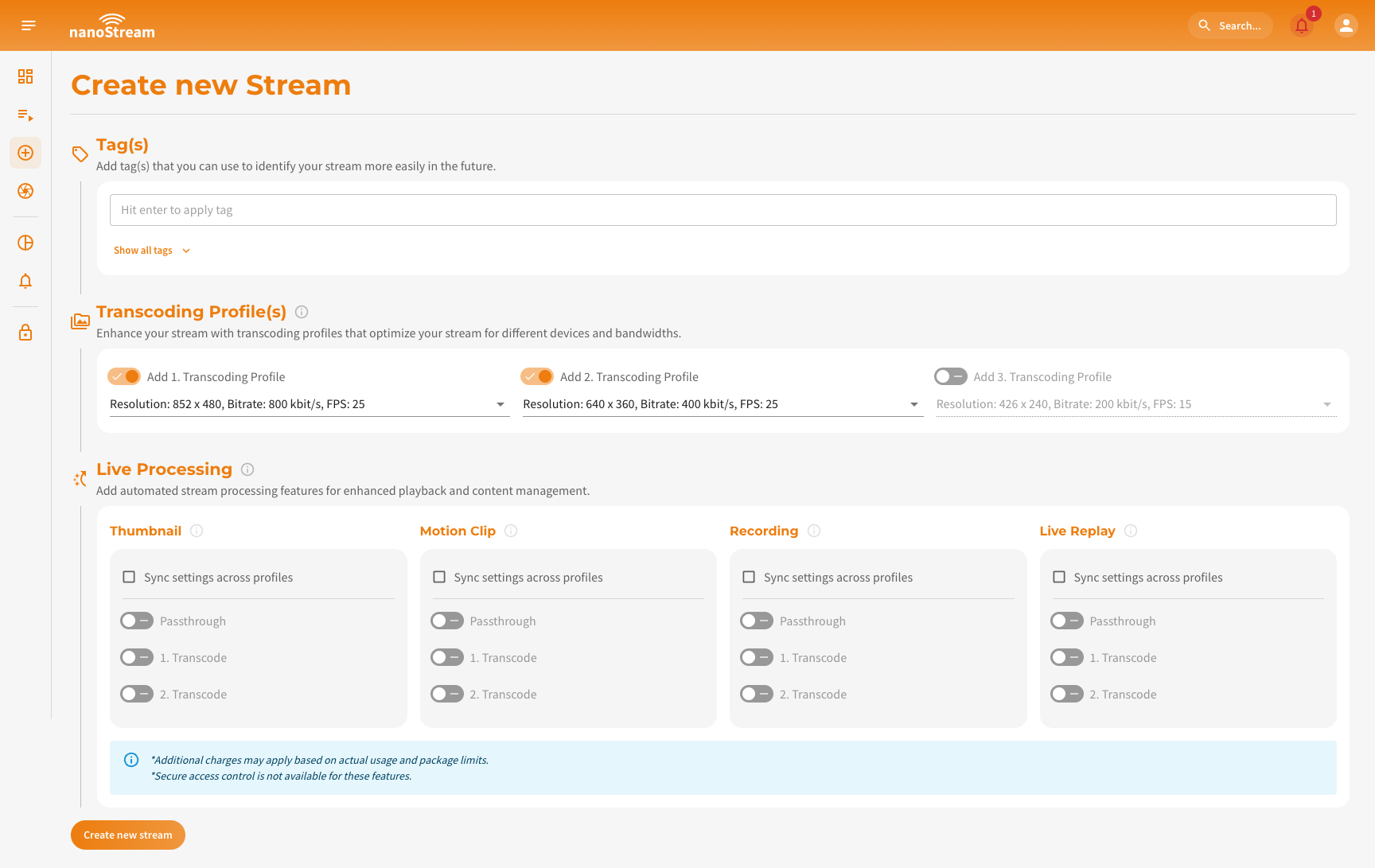 Screenshot: Create new Stream
Screenshot: Create new Stream
Tag(s)
In the Tag(s) section you can add tag(s) to identify your stream more easily in the future.
- Type your tag into the text field and press Enter to add it.
- As you type (from the 3rd character), suggestions based on previously used tags will appear underneath the textfield. By clicking on a suggestion it will be added to the taglist.
- Click Show all tags to see your most recently used tags and select from them.
 Screenshot: Adding tags to a new stream
Screenshot: Adding tags to a new stream
Transcoding Profile(s)
During the stream creation process live transcoding is already enabled by default. You have the option to add transcoding profiles and configure them according to your requirements. The default selection is pre-filled, but you can choose different settings. Ensure that the bitrate of each Transcoding Profile is lower than the ingest/passthrough bitrate or the profile above.
Adaptive Bitrate (ABR) and Live Transcoding work together to ensure seamless playback quality, even under unstable network conditions.
- ABR automatically switches between multiple stream qualities depending on the viewer’s bandwidth.
- Live Transcoding creates these multiple stream outputs from a single high-quality input.
👉 Dive into the Adaptive Bitrate and Transcoding section to understand how it works and when to use it.
As your streaming requirements evolve, you may find the need to revise your transcoding profiles. You can fully manage your stream profiles within the Stream Overview. Check Modifying Transcoding Profiles After Stream Creation for detailed steps and UI walkthroughs.
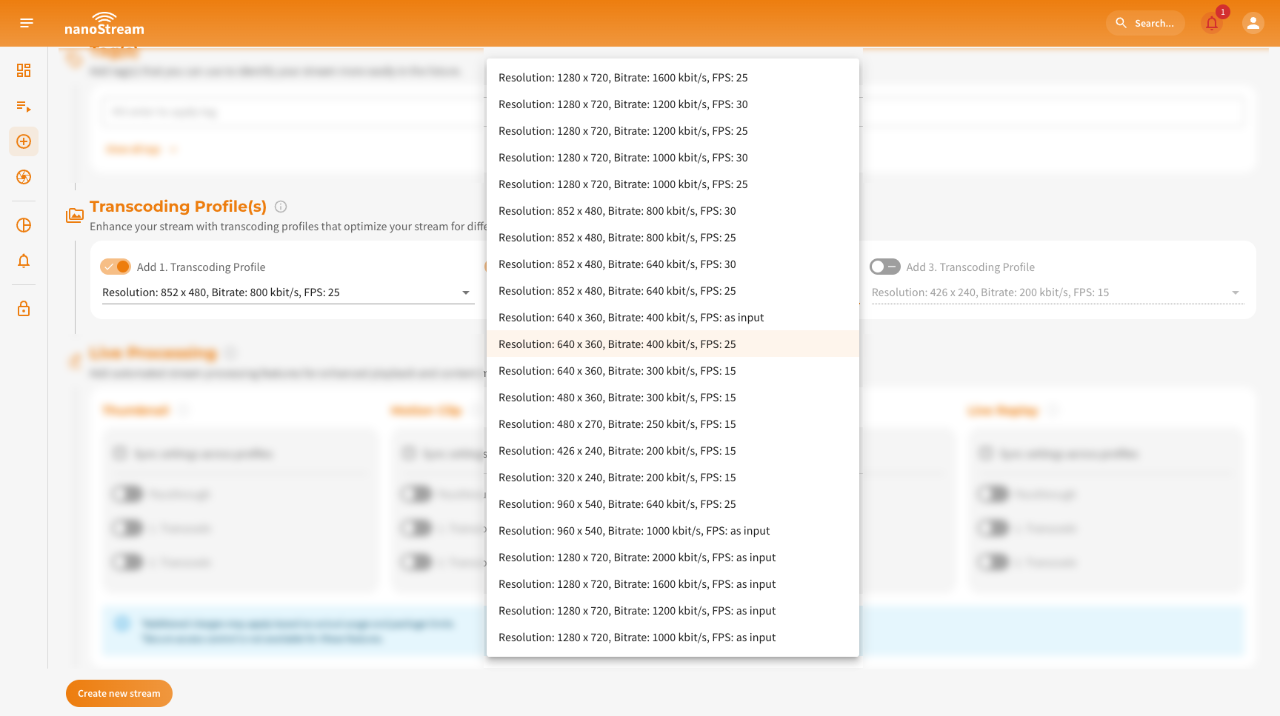 Screenshot: Adding transcoding to a new stream
Screenshot: Adding transcoding to a new stream
Live Processing
To utilize the live processing feature, you need to enable it and ensure the corresponding pricing and payment options are set up.
Contact us via nanocosmos.de/contact to find the perfect solution for you!
Live Processing lets you enhance your stream with additional automated features. You can either apply the same settings to all streams part of your ABR streamgroup by clicking on Sync settings across profiles or configure them individually.
Applying uniform settings is useful for Live Replay, while separate settings allow tailored configurations for different stream qualities.
Live Processing- Thumbnails & Motion Clips — Auto-generate visual snapshots & highlights.
- Recording — Save your stream sessions for later.
- Live Replay — Rewatch and share past moments instantly.
👉 Dive into the Live Processing Docs to understand how it works and when to use it.
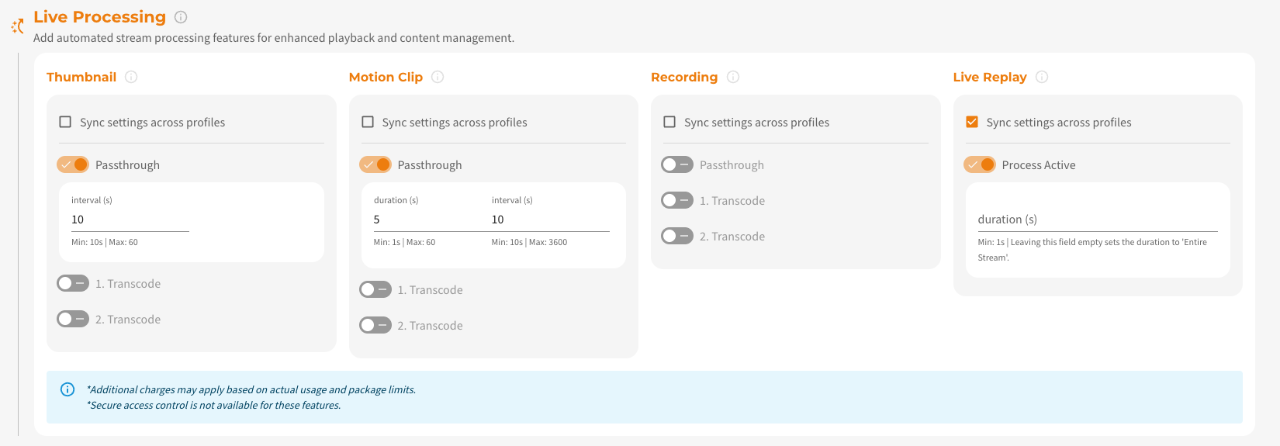 Screenshot: Adding live processing to a new stream
Screenshot: Adding live processing to a new stream
Timecode
To utilize the timecode feature, you need to enable it and ensure the corresponding pricing and payment options are set up.
Contact us via nanocosmos.de/contact to find the perfect solution for you!
By clicking on Add timecode you can enable this feature. It allows precise synchronization or indexing of video content. You can set the time injection interval between 500 ms and 3600000 ms (1 hour), while we recommend: 1000-5000 ms. The default is 2000ms.
 Screenshot: Setting timecode injection to a new stream
Screenshot: Setting timecode injection to a new stream
Start Streaming
After clicking on Create New Stream, you will be redirected to the Easy Instructions to Your Live Stream page. This page provides you with all the information required to start and share a stream, including the necessary steps and details for a seamless setup. You can also access this page later via the quick action button called Get Instructions in the Stream Overview.
All the information provided here is also available in the detailed Stream Overview for your reference.
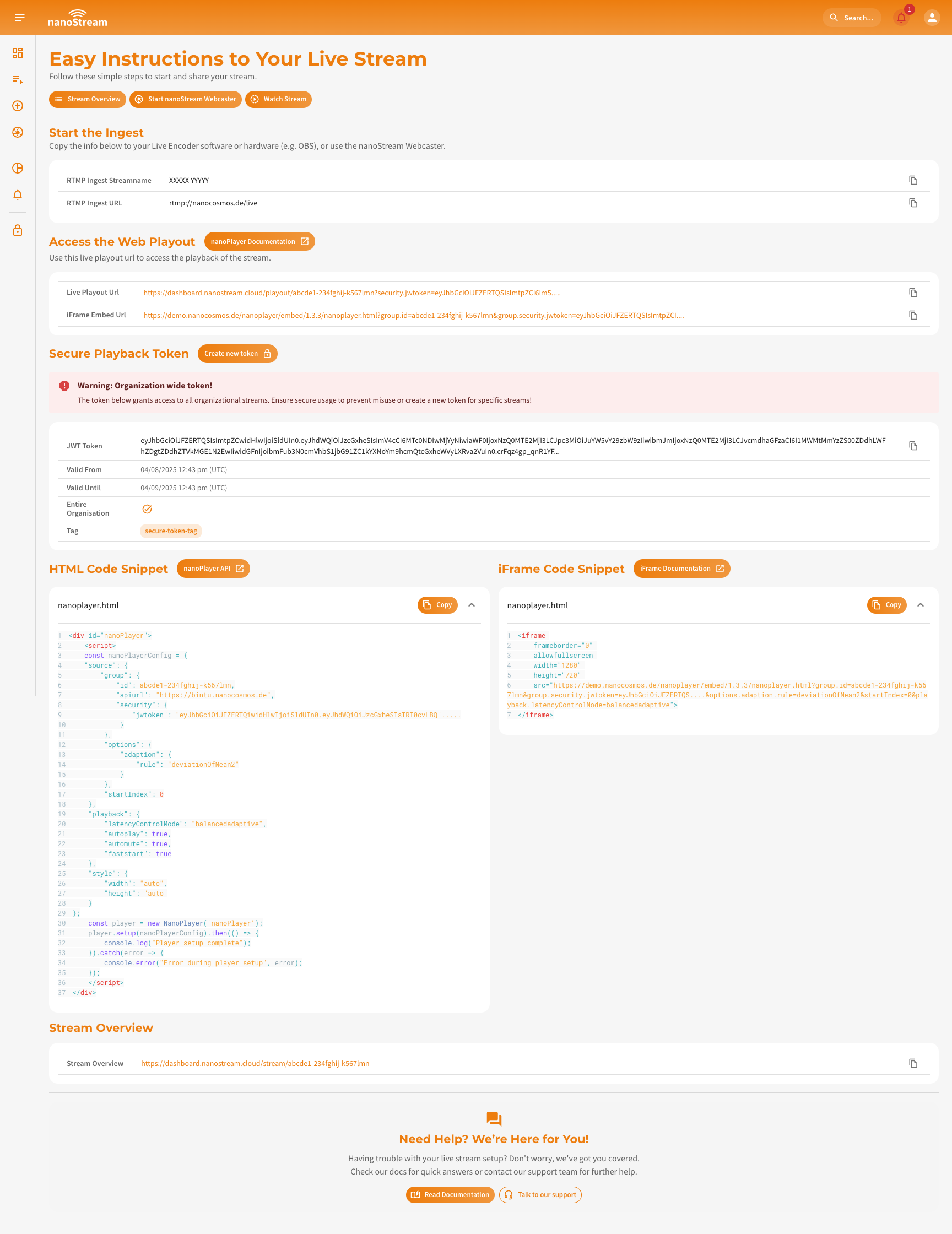 Screenshot: New stream Overview
Screenshot: New stream Overview
Under the Header of the page, you can see three buttons:
- Stream Overview: Takes you to the detailed stream overview page with additional stream information.
- Start nanoStream Webcaster: Redirects you to the Webcaster page where you can begin the ingest process immediately.
- Watch Stream: Directs you to the playout page where you can watch your live stream.
Below these three buttons, you can see the following sections:
- Start the Ingest: This section displays the RTMP stream name and RTMP URL needed to begin your stream. To copy the details easily, click on the copy icon next to the information.
- Access the Web Playout: Here you will find the live playout URL for streaming your content.
Enable secure playback
nanoStream also provides a
securefeature to generate a playback token. This lets you customize token settings like expiration date, not-before date, client IP, domain, user ID, or a tag for enhanced security.
You can verify whether this feature is available for your organization by navigating to dashboard.nanostream.cloud/organisation in your dashboard. To enable this feature for your organization, contact us via nanocosmos.de/contact. - Code Snippets: We provide two types of code snippets to embed the H5Live Player with your stream on your website: iFrame Code Snippet, HTML Code Snippet. You can simply copy and paste the appropriate code into your webpage to integrate the nanoStream H5Live Player.
- Stream Overview: This section provides a link to the full stream overview page. Clicking the URL will take you to the detailed overview with more relevant details about the stream.
Ingesting with the nanoStream Webcaster
The Webcaster interface is designed with simplicity and efficiency in mind, offering key elements that make live streaming easy.
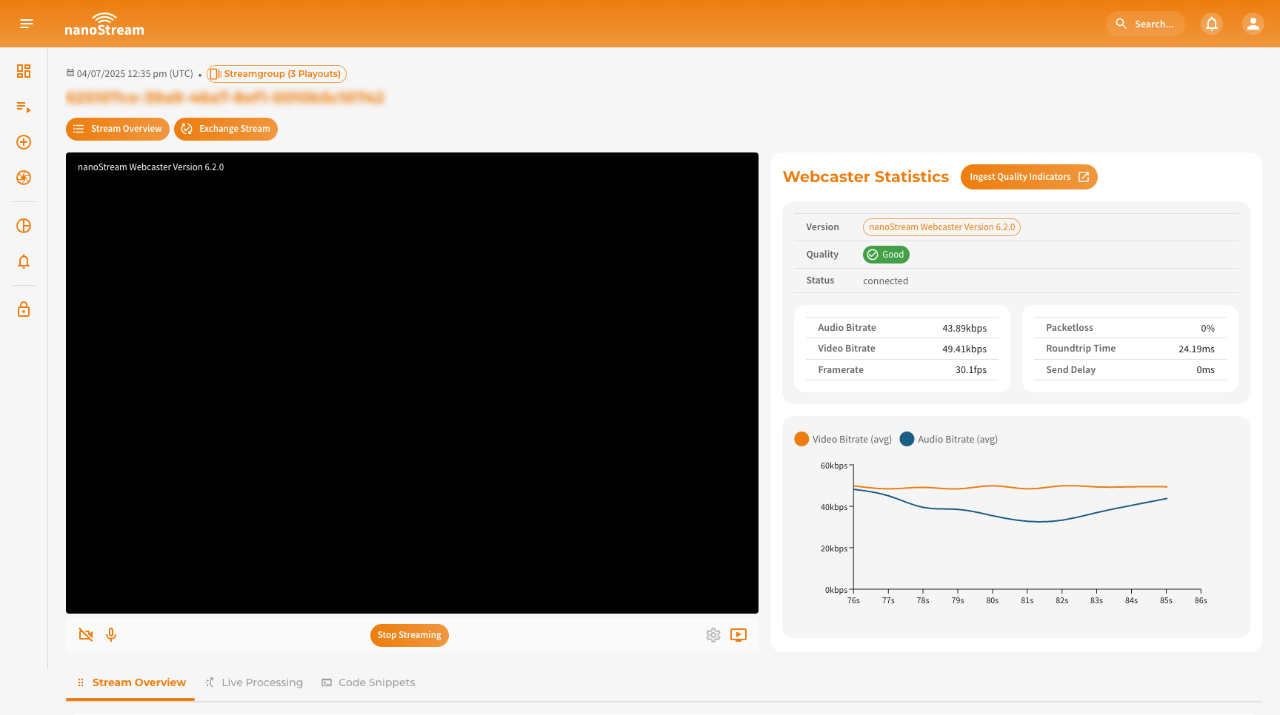 Screenshot: nanoStream Webcaster
Screenshot: nanoStream Webcaster
The Webcaster interface, shown in the screenshot, is divided into three main sections:
- Top left: The webcaster itself,
- Top right: Real-time statistics and
- Bottom: The stream details.
Toolbar
The Toolbar, located below the webcaster, acts as your command center, providing quick access to essential functions (f.l.t.r.):
- Camera On/Off: Toggle your camera.
- Audio On/Off: Control your audio input.
- Start/Stop Streaming: Initiate or conclude your live stream.
- Settings: Access detailed customization options.
- Playout Link: Quickly retrieve the link to share your live stream.
Settings
Tailor your streaming experience with the nanoStream Webcaster settings, accessible when you are not actively streaming.
-
Video Source: Choose between video feed from your camera or screen sharing. If you opt for screen sharing, a dedicated dialog will appear upon application of changes, allowing you to select the specific screen. Should you wish to switch to a different window, revisit the settings, click on screenshare again, and apply changes.
-
Video Quality: Adjust the maximum video bitrate, resolution, and framerate according to your preferences. Fine-tune these settings to achieve the desired balance between video quality and bandwidth efficiency.
-
Audio Configuration: Select your preferred audio input device and set the maximum bitrate to ensure optimal audio quality during your stream.
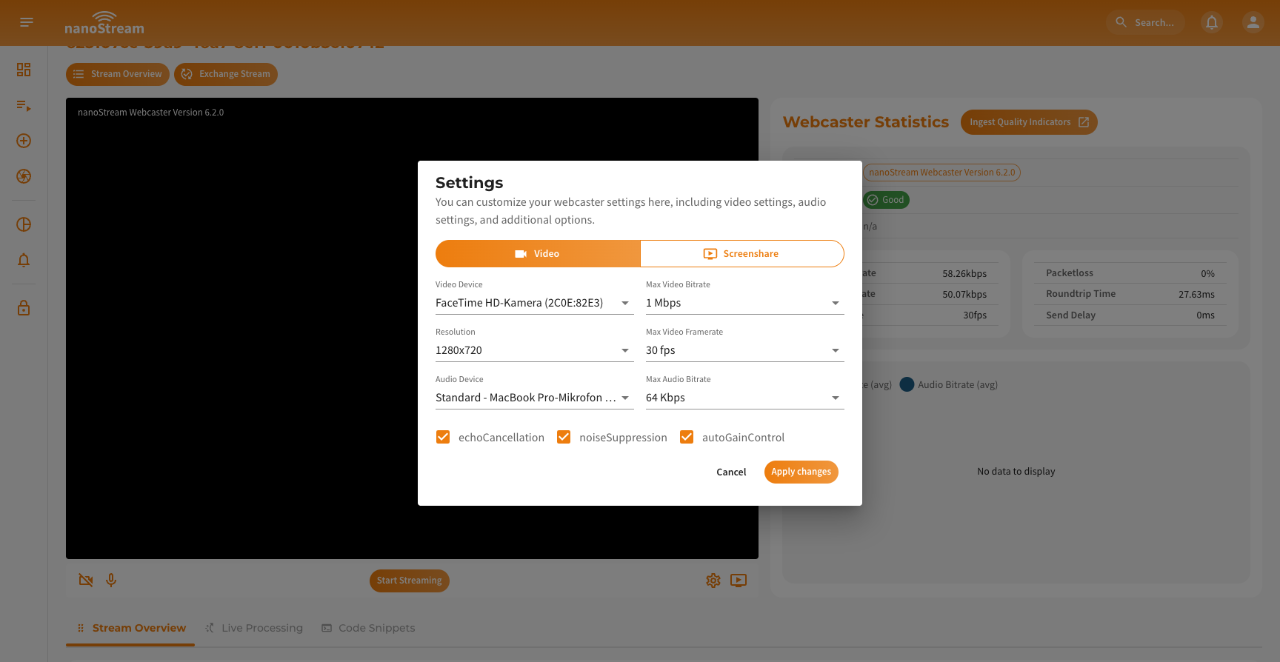 Screenshot: nanoStream Webcaster Settings
Screenshot: nanoStream Webcaster Settings
Webcaster Statistics
The statistics section provides stats and metrics to monitor the health and performance of your stream. Key metrics include:
- Packet Loss: An important indicator for stream stability, showing the percentage of lost packets during transmission.
- Round-Trip Time (RTT): Reflects the responsiveness of your stream by measuring the time it takes for data to travel from the source to the destination and back.
- Send Delay: Indicates the delay in sending data, which is critical for monitoring latency.
Additionally, there is detailed information on audio and video bitrates, as well as framerate. These metrics are visualized in a line chart during the broadcast for real-time monitoring.
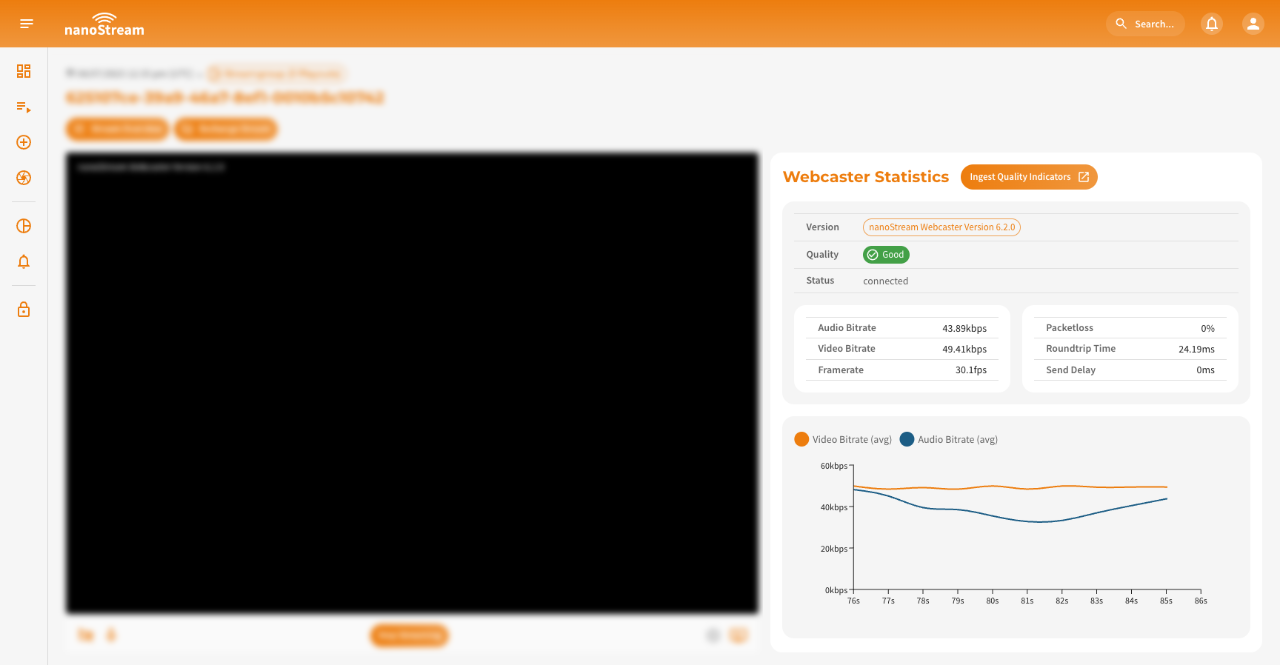 Screenshot: nanoStream Webcaster Statistics
Screenshot: nanoStream Webcaster Statistics
Ingesting with a separate live encoder software or hardware
- Configure your preferred live encoder software or hardware, such as OBS or Wirecast, according to the setup instructions.
- Obtain the necessary RTMP stream details (stream name and URL) from the Ingest section on the Stream Overivew or Easy Instructions to your live stream.
- Enter the RTMP stream details into your live encoder settings.
- Start the live stream from your encoder to begin sending the video feed to nanoStream Cloud.
- Read more about how to use OBS for Low Latency Live Encoding to nanoStream.
- Find also instructions how to use Wirecast with nanoStream Cloud in our blog.